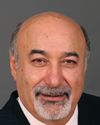I'll start off with the origin of the Taliban. I'll keep it short, but fundamentally the Taliban was a creation initially of the merchant class in Quetta, which was concerned about the routes leading through from Quetta to Spin Boldak to Kandahar for trade. At that time, Afghanistan was wracked in what we call the civil war or the war of the commanders, so there was essentially warlordism.
The Taliban then became augmented by the Pakistani intelligence services and the Pakistani armed forces and essentially became a tool of Pakistan to assert domination on Afghanistan, on what it saw as a chaotic situation. Then there's a radical Islamist thread that comes into that as well.
When they achieved control of part of Afghanistan--remember, they were resisted mostly by Tajik, Hazara and Uzbek populations, keeping in mind that the Taliban are predominately Pashtun, which is 38% of the population--they basically took control of large chunks of Afghanistan by the sword. Then they invited al-Qaeda in to create a series of base areas, and al-Qaeda developed a parasitical relationship with the Taliban.
Operation Enduring Freedom in 2001 strips away the Taliban shield so we can get at the al-Qaeda meat. So the Taliban disperses as an institution and flees to the south, and al-Qaeda tends to flee east and then into Pakistan.
Who are the Taliban? Fundamentally, we have different types of Taliban. One type would be the hard-core people from that period who have melted back to their particular villages or towns in the south. They may have been fighters at the fighter level. Then there's sort of a leadership caste, who decamp from Pakistan. They're mostly in Quetta and Balujistan. On top of this, you have hard-core jihadists. They're entering into Afghanistan, facilitated by Taliban cells. They're usually trained by al-Qaeda or affiliates. They could be Chechen, they could be Punjabi, or they could be Canadian. You get all sorts of people coming in who are facilitated into the country to do particular things. Then the Taliban has sort of a militia. They're trying to gain a constituency with teenage boys by approaching them with weapons, motorcycles, and money, and saying “Join us”. So you have these different layers.
The debate centres right now on what they want. The only thing we can infer is by their actions. As far as we can tell, they are interested in the southern part of Afghanistan. They do not appear to be interested in the non-Pashtun parts of Afghanistan right now, maybe later, but it's very evident to me that they're trying to create some kind of enclave. They're trying to drive us out of the south and create what I would call flippantly Pashtunistan, under a radical Islamic sort of caliphate structure, create this enclave that can't be assailed by the international community.
That serves a number of purposes. It serves the Taliban's purpose of trying to gain some form of control or domination over the tribal groupings in the south on both sides of the border. It serves an al-Qaeda purpose, because that becomes a psychological defeat of the west.
The fact that we're in Afghanistan and we kicked the Taliban and al-Qaeda out of it in the first phases of the war is our first victory over the al-Qaeda movement globally. This is very big, and you can look at it in the al-Qaeda documentation. They lament the loss of Afghanistan. When we're talking about different enemies and different objectives, it tends to be going in the same direction.
So if we're going to target those populations, we want to target them with different resources. The kid with the AK-47 and the motorcycle we may be able to convince away from that particular lifestyle. The jihadists we're not going to be able to convince; we'll have to kill them. The leadership caste we'll probably have to kill too. That's the way I'm looking at it right now. I'm not saying this is the only way of looking at it, but given the information we have right now, that's the best way of looking at what the objectives in insurgency are. They appear to be limited to the south right now, but they may have larger designs later.
I hope that answers your question.




